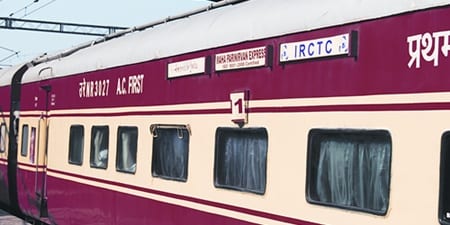On the trail of the Buddha
Launched in 2007 by IRCTC, the Mahaparinirvan Express has been attracting thousands of Buddhist pilgrims from Southeast Asia and the Far East. However, insufficient marketing at its home base and a high cost have been major reasons for its lack of popularity in India
The history of the cultural heritage of Buddha dates back to more than 2500 years ago. The influence of Buddhism can be seen across all Asian countries, but as a religion it rose in and around ancient Magadha in Bihar and is based on the teachings of Siddhartha Gautam (Buddha). At the beginning Buddhism was among the many small sects in India until King Asoka (ca 270-232 BCE) converted to Buddhism and went onto spread it throughout India and Sri Lanka. The rich reservoir of the Buddhist cultural heritage in India led to the inception of the Buddhist Circuit. This circuit is a route that begins from Lumbini in Nepal, where Buddha was born, through Bihar, where he attained enlightenment, to Sarnath and Kushinagar in Uttar Pradesh, where he gave his first teachings and died. This route only covers places where the Buddha was actually present and hence is an important pilgrimage en route for practising Buddhists and travellers from all over the world and India.
While Uttar Pradesh has various well-known religious and architectural destinations, Bihar has a rich asset of key Buddhist destinations with great tourism potential. According to a 2012 report titled ‘Identification of Tourism Circuits across India – Spiritual Circuit (Buddhism) Phase-I’ submitted by IL&FS Infrastructure to the ministry of tourism, Government of India, as per tourist estimates available (2008), out of the total tourist arrivals in Bihar, destinations coming under the Buddhist circuit of Bihar comprise 94 per cent of domestic and 98 per cent of foreign tourists. The report further stated that while Kushinagar, Sarnath, Gaya (Bodhgaya) and Rajgir are key destinations that have registered huge number of tourist inflows (both domestic and foreign); Kapilvastu, Shravasti, Sankisa and Vaishali are other potential destinations which can be developed as key tourism sites due to their increasing tourist inflows.
Trail tracks
In 2007, the Indian Railway Catering and Tourism Corporation (IRCTC) launched the Mahaparinirvan Express, a Buddhist Circuit train, to attract Buddhist pilgrims. The train derives its name from Mahaparinirvana Sutra, which contains Buddha’s final explanation of his teachings. The journey includes visits to the most important Buddhist pilgrimage sites of Lumbini, Bodhgaya, Varanasi and Kushinagar. The train is fully air-conditioned and offers three different classes of travel – first class, two tier and three tier. The major international markets for this train are the Far East, Thailand, Malaysia, Sri Lanka, among others. Despite the Mahaparinirvan Express’ growing popularity among international markets, it hasn’t been able to garner much attention in India. “The train is not well publicised in India for there is only a miniscule section of the people in India who are interested in Buddhist pilgrimage. Moreover, a majority of those going on this pilgrimage do not want to splurge and keep it budgeted. The starting price for this train is also high ranging anywhere between Rs 65,000- Rs 70,000 per person for eight days and seven nights,” stated Rajiv Varma, manager of Royal Indian Trains, an affiliate partner to IRCTC which promotes Maharajas’ Express, Mahaparinirvan Express and other luxury train tours operating in India.
The Mahaparinirvan Express is unlike the luxury trains operating in India. “Luxury trains like Palace on Wheels, Deccan Odyssey, The Golden Chariot, etc have rooms similar to that of five star hotels and have attached bathrooms as well, among other facilities. These trains cater to high-end tourists and cost anywhere between Rs 2.5-Rs 3 lakh per person for an eight day trip. They are essentially marketed towards the Americans and Europeans. But for the Mahaparinirvan Express, you are looking at a Far East market where the budget is comparatively lower. This train is a modified Rajdhani Express. The concept is that you travel overnight in the train, and in the morning you are taken to a hotel to freshen up and proceed for the tours and then return to the train to resume the rest of the journey. It has no attached bathrooms. So in terms of facilities, attached bathrooms can be made available but the costing will go haywire considering the type of tourists travelling and the pricing at which it is being offered presently,” reasons Varma suggesting that to create more global awareness, IRCTC needs to participate at international travel marts to promote this product.
To give a new fillip to the Buddhist tourism circuit in India, IRCTC started another Mahaparinirvan Express in 2013 to cover the Buddhist sites in Odisha. It was launched on a trial basis. The first journey was in January 2013 and the second journey was scheduled for October-November the same year but due to insufficient bookings, the train was discontinued. “The reason was the lack of marketing efforts by Odisha Tourism, IRCTC and the tourism body at the centre and as a result of this there was no demand. There needs to be consistent marketing efforts to make this product viable. It needs to be marketed in Southeast Asia and the Far East where there is a strong Buddhist population,” explains Sameer Kumar Das, director, Calingae Global LLP.



